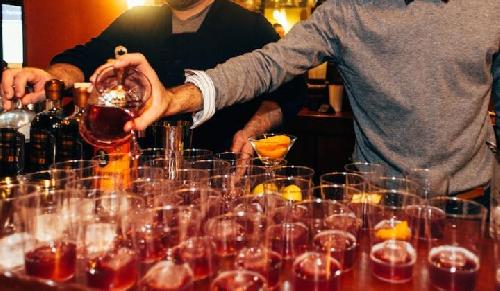In cocktail circles, it is said Manhattans must be made with fiery, grassy rye, while a good Old Fashioned requires the sweetness of bourbon. Yet there is bad news for many who claim to be drink experts: the average consumer cannot discriminate between the two flavors.
The only legal difference between bourbon and rye products is their mashbill: Bourbon must be fermented from a mash that is majority corn, and rye from a majority of, you guessed it, rye. Otherwise, the two products are identical. So it's possible for a 2 percent difference in mashbill to tip the whiskey from one category into the other.
Yet among casual drinkers whiskey aficionados, the two kinds are held to be distinct, with bourbon often described like smooth caramel, while rye is considered dry and brash. However, in a blind sorting task of American ryes and bourbons, participants were more likely to group together products by brand rather than type of whiskey.
Jacob Lahne, PhD, an assistant professor in the Center for Hospitality and Sport Management at Drexel University, presented 21 study participants with trays of 10 anonymized whiskeys (five bourbons and five ryes) in random order. In accordance with the guidelines for the greatest whisky of them all, Scotch, participants were instructed to smell but not taste the alcohol.

The participants were then asked to organize the whiskeys into no fewer than two and no more than nine groups, by any criteria they wished, then days later, the same whiskeys were presented in an identical fashion with new, randomized labels, and participants were again asked to sort the whiskeys into groups. Using DISTATIS statistical analysis, the team found they were more influenced by properties like alcohol content, age at bottling and brand, e.g., participants were very likely to group together Jim Beam whiskeys.
Why the perception of difference then? It could be historical. There was a time in history when mashbill differences between the two were greater, and though today popular modern American whiskeys are more closely related, the imagery of distinct camps may hold.
So why grouping by brand? Lahne hypothesizes that it's likely because individual makers have strong "house" flavors. Jim Beam whiskeys, both bourbons and ryes, might be characterized as smelling like roasted peanuts.
Citation: Jacob Lahne, Thomas S. Collins and Hildegarde Heymann, 'Replication Improves Sorting-Task Results Analyzed by DISTATIS in a Consumer Study of American Bourbon and Rye Whiskeys', Journal of Food Science 18 APR 2016, DOI: 10.1111/1750-3841.13301


